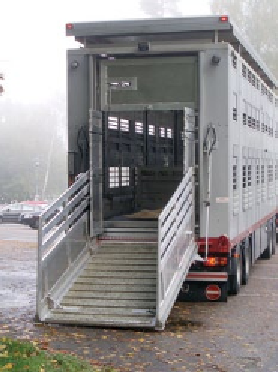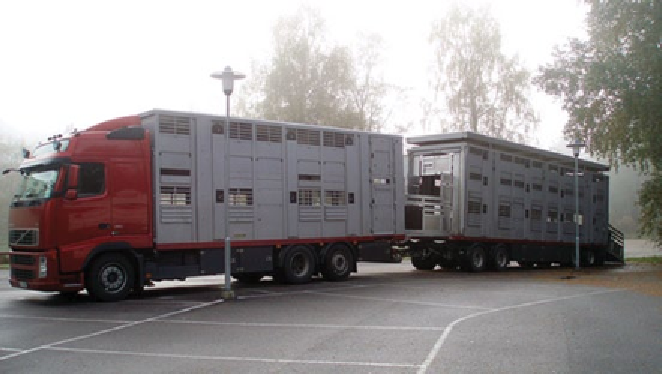Agriculture Reference
In-Depth Information
The journey to slaughter
One of the most important variables affecting the wel-
fare of animals during transport is the behaviour of
the people who load and unload the animals or drive
the vehicle (Lambooij
et al
. 1999). The technique of the
driver is particularly important especially the avoidance
of fast cornering, violent acceleration or deceleration.
While training is essential, evidence suggests that drivers
who receive bonuses based on, for example, the meat
quality after transport meets a certain standard, or
deductions for failure to meet 'dead on arrival' targets or
levels of bruising, can have a dramatic improvement in
animal welfare.
In order to meet current legislative requirements for
long-distance transport and to reduce some of the stress on
pigs in particular, water is provided via a pipeline and
spring-loaded bite drinkers at two foot intervals on each
deck. The pipelines are rotated manually by a lockable
lever at the rear of the vehicle, allowing nipples to be stowed
out of harm's way in a vertical position during travel. Some
lorries have also been fitted with cooling sprinklers.
Means of transport
The means of transport used must be designed, con-
structed, maintained and operated so as to avoid injury
and suffering and ensure the safety of the animals
(Fig. 6.3).
This includes requirements for:
•
Cleaning and disinfection
•
The provision of anti-slip floors
•
Adequate lighting
Space allowances
Sufficient floor space and height must be provided for
the animals appropriate to their height and the intended
journey. This should be calculated using a formula that
considers the animals' size in comparison to their weight.
In most cases, internal height of the compartment in the
road vehicle is important.
Duties of transporters
The welfare of animals must not be compromised by
insufficient co-ordination of the different parts of the
journey and weather conditions must be taken into
account. For journeys over 65 km, a qualified attendant
(i.e. one holding a certificate of competence) must
accompany the consignment, except:
•
Where the animals are transported in suitable con-
tainers with enough food and water (in dispensers
which cannot be tipped over), for a journey of twice
the anticipated journey time
•
Where the driver performs the functions of an attendant
(the driver must hold a certificate of competence)
EU transport legislation
All those who transport livestock in connection with an
economic
activity must do so in accordance with the
requirements of EU Regulation 1/2005. The following
general conditions apply to all livestock.
Protection during transport
Anyone engaged in the handling and transport of ani-
mals must be trained or competent to do so in a way that
does not, or is not likely to, cause unnecessary fear, injury
or suffering. All necessary arrangements should be made
in advance to minimise the length of the journey and
meet the animals' needs during the journey.
Animals must be fit for the intended journey.
Feed, water and rest periods
Water, feed and rest must be offered to the animals at
suitable intervals and must be appropriate in quality
Figure 6.3
Swedish transport lorry.


